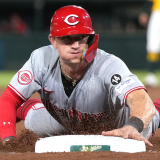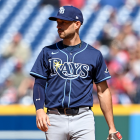
Royals' path back to contention will rely on homegrown talent -- much like their 2015 World Series run
GM Dayton Moore is rebuilding once again in Kansas City
For nearly three decades, the Royals lost games at a horrifying rate. They went a stupefying 29 years between playoff berths, the longest postseason drought in baseball by a wide margin.
On June 8, 2006, Dayton Moore took over as the Royals' general manager. K.C. picked Moore on the strength of his background in scouting and player development with the Braves, the team that went on to ride homegrown talent to an amazing 14 division titles in 15 years. This would be the blueprint for the next winning team in Kansas City.
For a long time, Moore's efforts appeared to fail miserably. The Royals finished that 2006 season with 100 losses. They went on to post six more losing seasons thereafter, making it just one above-.500 campaign in 18 seasons following the '94 strike. When asked why progress seemed to be taking so long, Moore would urge patience. Trust The Process, he would say repeatedly.
After years of mocking a Process that never seemed to bear fruit, fans would soon get rewarded for the wait. The 2013 Royals were one of the surprise teams in baseball, gaining 14 wins from one season to the next to finish an impressive 86-76.
The next two years were magical. First, K.C. won 89 games and a wild-card berth, snapping that playoff-less streak and surging all the way to the World Series. The next season, they climbed all the way to the mountaintop, winning their first Fall Classic in 30 years while serving notice that small-market, small-revenue teams could not only compete with the big boys, but also win it all.
- 2018 Result: 58-104, fifth place in AL Central
- Key free agents: Alcides Escobar, Jason Hammel
- Needs: Third base, starting pitching, outfield
Three years later, the Royals are in full rebuild mode. The core of that championship team has scattered to the winds, and K.C. bottomed out with 104 losses last season. Twelve and a half years after he built Kansas City's first winning team in a generation, Moore gets a shot to do it again. Will he follow the same blueprint the second time around?
For those who need a refresher, the Royals succeeded in large part because they zigged while the rest of the sport zagged. As hitters resigned themselves to record-setting strikeout levels in pursuit of home runs, K.C. ranked just 24th in the majors in long balls the year the team won the World Series. While other managers eschewed stolen-base attempts for fear of erasing baserunners in front of power hitters, the Royals finished second in the American League in steals. And while strikeouts became acceptable for everyone else, the Royals struck out less often than other club -- by far.
The same against-the-herd approach played out with the Royals' pitching staff. In that magical 2015 season, K.C.'s starters ranked 23rd in Wins Above Replacement, 24th in innings pitched, and 25th in strikeout rate. This wasn't by design per se, but it wasn't an accident either. Aside from deadline acquisition Johnny Cueto (who didn't pitch all that well once in K.C.), the Royals mostly leaned on journeymen and unproven commodities in their rotation, with mixed results. The bullpen was another matter altogether, though. For the second year in a row, the nasty trio of Greg Holland, Wade Davis, and Kelvin Herrera mowed down opposing hitters, this time with the help of a monster season by veteran pickup Ryan Madson.
You could thus boil down the strategy of the glory-years Royals to this: Get through five innings tied or close, and K.C. would find a way to steal the run or two it would need to beat you, then shut you down with an unhittable bullpen.
At first glance, replicating that strategy to build another winner in Kansas City would seem extremely doable. J.D. Martinez and former Royal linchpin Lorenzo Cain finished in a virtual dead heat last season for Wins Above Replacement. Yet Martinez's 43 homers and 130 RBI from the DH spot cost the Red Sox $110 million over five years, while Cain's far more well-rounded game, with 30 steals, stellar defense in center field, and one of the lowest strikeout rates in the league, cost Milwaukee a more reasonable $80 million over five years. On the pitching side, the Royals' multi-headed bullpen beasts approach makes more and more sense with average innings pitched by starters dropping league-wide year after year.
The Royals have already dropped hints that they're trending in that direction this time around, even if it might take years before that approach bears fruit. K.C.'s two top position players last season (by far) by Wins Above Replacement were second baseman Whit Merrifield and 23-year-old shortstop Adalberto Mondesi. The two middle infielders not only came through at the plate; they were also demons on the basepaths, swiping an eye-popping 77 bases between them, with Mondesi himself bagging 32 in just 75 games.
Meanwhile, the Royals' three most notable position player pickups so far this offseason are all speed merchants: Superutility man Chris Owings has bagged double-digit steals in each of the past four seasons, center fielder Billy Hamilton swiped 56, 57, 58, and 59 bags with the Reds from 2014 through 2017 before the Royals scooped him up last week, and Terrance Gore is a returning Royal who had multiple key baserunning moments in the postseason for K.C., despite being ostensibly a full-time pinch-runner.
Still, copying the Royals' 2014-2015 blueprint for success might be easier said than done. K.C.'s model for building a pitching staff, has spread across the league, with teams spending more in both cash and prospect capital to build dominant bullpens. That includes setup and even middle-relief roles, with teams realizing that going four-, five-, or six-deep in high-level relievers can take a huge amount of stress off a starting rotation, and create more opportunities for late-inning wins.
Moreover, the Royals' success wasn't merely a product of Cain, Gore, and Jarrod Dyson running wild on the basepaths. It wasn't even a matter of committing more resources to scouting and player development; half the American League is currently doing that, and not every team will succeed at it.
What made the Royals great was the concurrent development and acquisition of multiple All-Star-level performers. Yes, Cain, Eric Hosmer, Salvador Perez, Mike Moustakas, and Alcides Escobar offered an impressive combination of high-contact hitting, as well as solid defense and baserunning prowess (albeit much less so for Perez and Moustakas). But they were also simply good to very good players all around the same age who happened to become good at the same time. For a revenue-challenged team like the Royals that won't pursue big-dollar free agents, that is the key to making deep playoff runs.
So yes, a young, toolsy, ultra-speedy player like Mondesi could become a building block for the next winning team in Kansas City. But the same could be said for power-hitting first baseman Ryan O'Hearn and some of the young pitchers coming up through the Royals system, some of whom could end up making an impact in the rotation as opposed to the bullpen.
Build a better nucleus of talent than your competition, and you're likely to win. The types of players who populate that nucleus isn't as important. And it's not nearly as predictable.
Jonah on the MLB offseason
NL East
Braves: May be offseason's most compelling team
Marlins: Finding where to send Realmuto
Mets: How Mets could jumpstart BVW era
Phillies: Harper or Machado might not be enough
Nationals: What will the Nats do if Harper leaves?
NL Central
Cubs: Keys to a Cubs rebound in 2019
Reds: Can Cincy revamp its pitching staff?
Brewers: Why Milwaukee should dig deeper in its war chest
Pirates: How Buccos can get aggressive
Cardinals: St. Louis can close the NL Central gap
NL West
Diamondbacks: How drastic will the rebuild be?
Rockies: Colorado needs bats to match pitching staff
Dodgers: How L.A. can spend big this winter
Padres: San Diego is the biggest mystery team of the offseason
Giants: Trading MadBum and others makes sense
AL East
Orioles: Nowhere to go but up for new O's leadership
Red Sox: Active offseason could lead to World Series repeat
Yankees: Machado fits Yanks' wants and needs
Rays: Tampa in position for unusually aggressive winter
Blue Jays: Toronto needs to embrace rebuild
AL Central
White Sox: Compelling dark horse in Harper, Machado races
Indians: Why a Kluber or Bauer blockbuster makes sense
Tigers: Detroit facing plenty of rebuilding competition


















